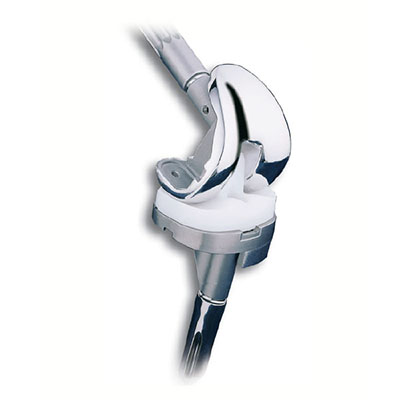
Total Knee Replacement (TKR) is one of the most successful orthopaedic procedures of modern era. When there is a severally damaged osteoarthritic knee and the joint is completely degenerated, total knee-replacement surgery is the preferred procedure. In this procedure the surgeon shaves the damaged cartilage from the bone ends and replaces it with a new surface called prostheses, which can be made form alloy-metal, high-grade plastic and polymers. Use of advanced technology in knee replacement surgery has made this procedure more accurate and long lasting. The long-term success rate for total knee surgery currently has exceeded 98%. The availability of advanced materials, such as titanium prostheses and new plastic joint liners, provide orthopaedic surgeons with options that help increase the longevity of the prosthesis.
The usual life of a successful total knee replacement is about 20 years. It may however vary under individual circumstances. If primary surgery is not successful then a revision knee replacement surgery is required where a part or the whole of the previous knee replacement needs to be revised.
There are several reasons for the failure of knee implants. Some of these reasons are wear, loosening, infection, fracture, instability, and patient related factors.

An unsuccessful primary knee replacement implant is usually indicated by an increase in pain or a decrease in knee function. Constant pain and swelling can indicate loosening, wear, or infection, and the location of the pain can be all over the knee or in one particular area.
The symptoms of failed primary knee replacement implant are limpness, stiffness, or instability. Patients who demonstrate these symptoms and signs may require revision joint surgery.
Revision Total Knee Replacement is the replacement of the previous failed total knee prosthesis with a new prosthesis. It is a complex procedure that requires extensive preoperative planning, specialised implants and tools, prolonged operating times, and mastery of difficult surgical techniques to achieve a good result.
While doing revision Total Knee Replacement, the surgeon will remove the primary Total Knee Replacement implants and prepare the bone fresh for revision implants. Removal of primary implant may need specialised tools and burrs. Revision implants are complex to use and often augments, rods, etc. are used to compensate for bone loss.
Post-operative care after knee revision surgery is very similar to the care of a primary knee replacement. This includes a combination of physical therapy, blood management, and pain medication as necessary. Antibiotics and some method of blood clot prevention will be continued in the postoperative period. A brace or splint may be used to protect the joint after the surgery.
Recovery time after revision knee surgery is the same as primary knee replacement surgery and the results are as good as primary knee replacement surgery.
Greater than 90% of patients who undergo revision procedures can expect to have good to excellent results which includes pain relief with increased stability and function.
Revision knee replacement surgery is a complicated procedure and requires highly professional expertise.